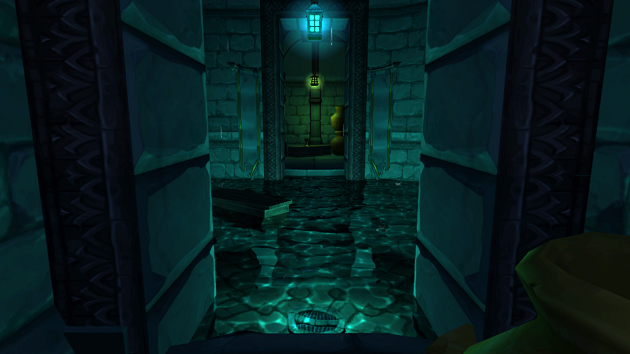
I’ve spent multiple weeks with Valve and HTC’s virtual reality headset, the Vive, the first consumer VR device to feature room-scale technology, and have come to one relatively finite conclusion.
The Vive’s hardware is both capable and impressive, even when running off my AMD RX 480 graphics card paired with an aging FX 8370 processor, but, despite how compelling some Vive experiences are, many of the games currently available for the headset feel more like elaborate proof-of-concept tech demos. It’s unclear if this is a result of developers not yet getting the hang of the Vive’s burgeoning tech yet, or if it’s simply just too early in the headset’s lifecycle.
That doesn’t mean, however, that there aren’t Vive games worth playing out there right now.
I’ve played a lot of Vive games over the last few weeks. Titles like Selfie Tennis and Space Pirate Trainer do a tremendous job of showing off what the Vive is capable of, but from a gaming perspective, offer up a lacklustre experience once their initial wow factor has worn off.
It wasn’t until my second week with Valve’s room-scale virtual reality device, that I began to uncover deeper gaming experiences that have the potential to appeal to a more hardcore demographic.
Generally, I think it’s worth noting that despite the graphical power of my recently upgraded PC, I still ran into occasional motion tracking issues and game crashes. Also, even though the Vive features a 2160 x 1200 pixel display, the same resolution the Rift also adopts, individual pixels are still very noticeable, detracting from the overall experience. Both when it comes to high-end PC-tethered VR and more low-end devices powered by smartphones, virtual reality is poised to help push the argument for displays that pack a greater number of pixels.
That’s not to say there aren’t other games worth playing on the Vive that haven’t made this list. Recently released Zombie shooter Arizona Sunshine, Hover Junkers and another Canadian developed title, Fantastic Contraption, all offer in-depth gameplay experiences.
Here are four Vive games you should definitely check out.
Vanishing Realm: FPS Zelda
If you’re like me, you probably played The Legend of Zelda Ocarina of Time for the Nintendo 64, and imagined what the game would be like if you could view it from Link’s perspective, as well as if you had the ability to wield a virtual sword and shield from first-person. This is exactly what Indimo Labs’ Vanishing Realms does.
The game is one of the first HTC Vive experiences that legitimately made me forget about the world around me to such a level that I often accidentally hit the wall with the Vive’s controllers. While Vanish Realms’ room-scale functionality works reasonably well in a small play space, the experience is significantly better when there is more room to move around. Because of my tiny apartment, I was often forced to use the controllers to move my character, pointing and clicking on different objects to move forward.
Vanishing Realm’s battles, which require the player to use their shield to block enemy attacks and slash with their sword when an opening appears, unfortunately often devolved into me randomly slashing my sword in front of myself frantically.
This mostly happened because enemies aren’t very intelligent and follow a predictable attack and defence loop, making them easy to take down once you learn each foes’ pattern. Shooting a bow and arrow on the other hand, while not as realistic feeling as it is in Valve’s excellent Labs demo, is a satisfying experience.
Still, there’s something special about this game and if you’re an HTC Vive owner it’s definitely a must-play.
Vanishing Realms is $21.99 on Steam.
Time Machine VR: Seated action
One of the main challenges I’ve experienced with the Vive so far is that I need to be in the right head space to use the device. If I’m tired, or don’t feel like engaging with an experience that requires me to be constantly moving my entire body, using the Vive unfortunately (and fortunately depending on how you look at it) really isn’t an option.
MinorityVR, a subsidiary of Montreal-based Minority Media, has created a game that fills this void to some extent. Time Machine VR throws the player into the role of a time traveling prehistoric animal researcher. Players are tasked with placing probes and scanning creatures for valuable information, all from a seated position, which means the game doesn’t take advantage of the Vive’s room-scale technology.
However, after a grueling session of Space Pirate VR, Time Machine is a relaxing change of pace. It’s important to note that I did become slightly motion sick from the game sometimes, a feeling I haven’t felt when playing VR games before with the Vive or even the Oculus Rift. While I can’t be certain, I think it’s Time Machine VR’s lack of room-scale and emphasis on always looking around that caused the nausea, resulting in me repeatedly experiencing virtual movement that wasn’t actually happening in the physical world.
Still, in small bursts, Time Machine VR’s dinosaur researching mixed with Back to The Future-style time-traveling is a compelling and surprisingly educational introduction to virtual reality, though I do wish the game took advantage of the Vive’s room-scale functionality.
Time Machine VR is $29.99 on Steam.
Call of the Starseed: The Gallery Ep. 1
Call of the Starseed: The Gallery Ep. 1 (try to get past the game’s horrible name), created by Victoria-based developer Cloudhead Games, the third and final title I’m taking a look at this week, best shows off what virtual reality is capable of on a narrative level, successfully translating the old school point-and-click adventure genre into virtual reality.
Through realistic characters, complete with the same level of motion capture and voice acting you’d expect from big budget game, players slowly unravel the game’s story. Puzzles, as far as virtually reality’s current limitations go, also make sense. They typically encourage the player to pick up a specific object and examine it, or throw an item in a certain location.
For example, one puzzle early on in the game requires the player to shoot a flare gun, after loading it with individual flares of course, at bells placed all over the map.
Visually, The Gallery is also one of the more impressive looking games available for the Vive right now, allowing the player to crank up a variety of visual settings if they own a more powerful VR-capable gaming PC. For example, when I first tried the game, I experienced a small amount of lag that I assumed was the result of my outdated processor.
When I went through the process of installing the AMD FX8370 processor, which required to get my hands on a new power source (PSU) and motherboard (I got the ASUS 970 Pro Gaming/Aura AM3+), forcing me to rewire my entire computer, I was able to crank up the fidelity, leading to a more immersive experience.
Call of the Starseed’s major innovation, however, related to how you navigate in the game. In order to get around room-scale limitations, players just look where they want to move and click on one of the Vive controller’s triggers. This method of moving around a virtual game world, called “Blink Navigation,” feel much more natural than the point and click alternative moving around present in Vanishing Realms.
The first episode of Call of the Starseed: The Gallery is available for $38.99 on steam
Related reading: Reality Bytes: Taking the HTC Vive’s ‘Blue Pill’






